

Salamanca, Spain
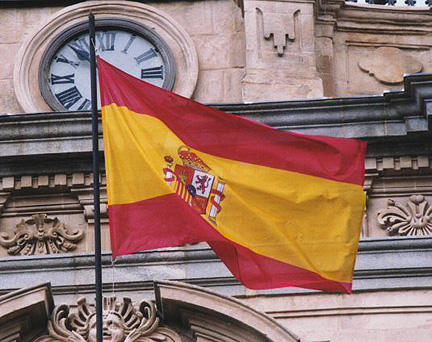
the Spanish flag
![]()
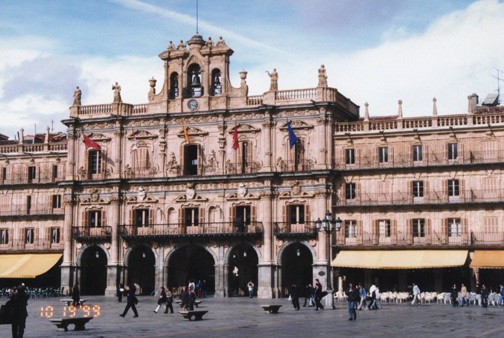
the main square
A stroll through the streets of
Salamanca is the discovery at every turn of monuments steeped in history and
wisdom, medieval towers alongside plateresque façades, and Baroque reredoses in
Modernist buildings. This is a dynamic, welcoming city, the fruit of its
position on the Vía de la Plata and its university history.
The axis that runs from the church of San Marcos - the circular plan of which
constitutes an original example of the Romanesque style - to the Roman bridge
over the river Tormes, takes in the most emblematic points of the city.

La Iglesia de San Martin
Calle Zamora leads from St Mark's
to the Plaza Mayor, one of Salamanca's jewels and one of the of the most
important main squares in Spain. Arcaded in the Churrigueresque Baroque style,
one of the main features is the so-called Pabellón Real (royal pavilion),
decorated with a bust of Philip V. It contains numerous medallions, several of
them of key figures associated with the history of the city, such as Friar Luis
de León and Unamuno, and others representing writers and professors of the
University of Salamanca. Emerging from amidst the eighty or so arches around the
square, and designed in the same style, is the City Hall. In the old-style bars
and restaurants located here, visitors may sample the local dishes.
The route to the so-called Casa de las Conchas (House of Shells), the
Renaissance façade of which is adorned with more than 300 pilgrim shells (the
symbol of the order that protected the pilgims' road to Santiago de Compostela),
takes in Rúa Mayor. This street contains major Renaissance palaces, such as the
16th-century palaces of Salina, Orellana and Anaya, whilst situated nearby is
the so-called Clerecía or monastery, a Baroque construction that now houses the
Pontifical University.
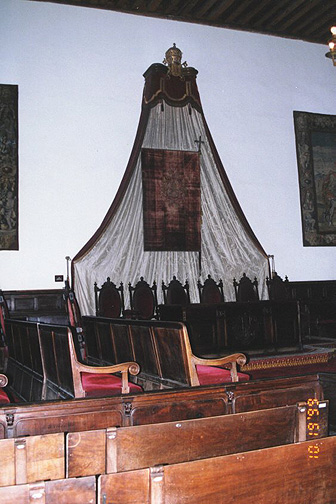
Law faculty classroom of the University
The University of Salamanca is
situated only a stone's throw away. Founded in 1254 by Alphonse X, also known as
Alphonse the Learned, it is one of the oldest such institutions in Spain.
Construction of the present-day building commenced during the 15th century in
the Gothic style, although the main façade is plateresque. It displays a
medallion with the effigy of the Catholic Monarchs and the coat of arms of the
Emperor Charles V. Local tradition dictated that the figure of a frog on a skull
be found to guarantee academic success. An annexed building houses the so-called
Escuelas Menores (Minor Schools).
Situated in the same Plaza de Anaya, together with the Anaya palace and the
University, is the New Cathedral. Adjoined to this building, creating a complex
of great beauty and balance, is the Old Cathedral. Commenced in the 12th
century, the latter building combines Romanesque and Gothic elements. The most
outstanding external feature is the Torre del Gallo (Tower of the Cockerel), a
Byzantine-inspired gadrooned dome on a double tambour. The cloister leads to the
Chapel of Santa Bárbara, where prospective Doctors of Philosophy would keep
vigil the night before their final exam: if they passed they would ring the
bells, whilst failure meant exit via the Carros door. The ground plan of the Old
Cathedral was altered when the New Cathedral was adjoined. Commissioned by the
Catholic Monarch, King Ferdinand, the New Cathedral is designed in the late
Gothic style with Renaissance ornamentation, whilst the tower was constructed by
the Churriguera brothers, the main practitioners of the Spanish Baroque style.
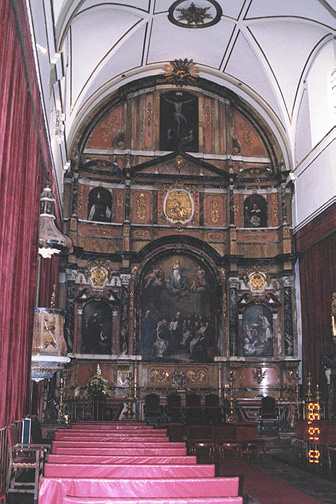
University chapel
Here, en route to the Roman
bridge over the river Tormes, the itinerary takes in the Casa Lis. This
Modernist structure of iron, ceramics and glass houses the Museum of Art Nouveau
and Art Deco, with more than 1,600 items of decorative art from the 19th and
20th centuries.
The other side of the river affords one of the best panoramic views of the city.
It is precisely on this bank of the Tormes that the city's parador is situated.
A modern building with all the conveniences of a four-star hotel, it has as
excellent views over this World Heritage city. Its restaurant provides an
opportunity to sample the local cuisine. Having tried the odd dish in the
old-style bars and restaurants of the historic quarter, now is the time to taste
more elaborate casseroles. Roast suckling pig and young goat can be followed by
"hornazos" (a type of pie) and "farinatos" (sausages made from breadcrumbs, pork
fat and spices). The sweetmeats are based on Arabic, Hebrew and convent recipes.
Marzipans (with sugar and almond) from the Monastery of Santa María de Dueñas,
caramel-coated almonds from Alba de Tormes, and "bollo maimón" (a spongy type of
marzipan) are just some of those on offer.
Salamanca also boasts important churches and convents dating back to the period
when all the professors at the University were monks. Situated close to the
cathedrals is the Plaza del Concilio de Trento, which contains two important
religious constructions: the Convent of San Esteban and the Convent of Las
Dueñas. The former has a carved façade, in the fashion of a huge reredos, whilst
its interior preserves a reredos by Churriguera and paintings by Claudio Coello.
For its part, the Convento de las Dueñas combines vestiges of the Gothic,
Mudejar and plasteresque styles, its founder having built it on her own palace.
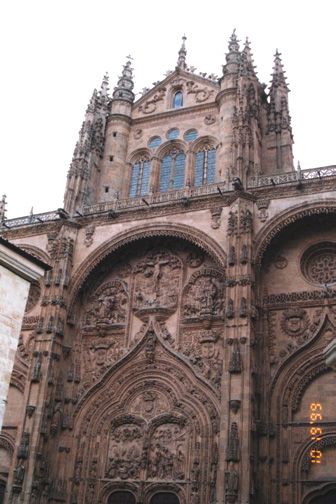
Cathedral
The province of Salamanca can be
toured by following interesting itineraries. One of these is the so-called Vía
de la Plata ("Silver Route"), a Roman road that linked Seville and Astorga and
was later used by the pilgrms en route to Santiago de Compostela. This itinerary
through the province takes in Alba de Tormes, Guijuelo and Béjar. Romanesque-Mudejar
churches, drying sheds for ham with Label Guarantee status and medieval
constructions are, respectively, some of the area's charms.
The Sierra de Francia range also comprises other unmissable sites, such as La
Alberca, a village with National Historic Heritage status, and Miranda del
Castañar, an Historic-Artistic Site, as well as natural beauty spots such as the
Peña de Francia rock and the Las Batuecas valley.
The so-called Campo Charro leads on to Ciudad Rodrigo, one of the province's
most historic places, and to the Sierra de Gata mountain range. Meanwhile, the
river Tormes reveals the historic towns that have gradually emerged along its
banks, such as Almenara de Tormes, Ledesma and San Felices de los Gallegos.
Text from Spain.Info
![]()
Photos of Flamenco dancers from Salamanca
![]()
Return to Elderhostel in Portugal page
![]()